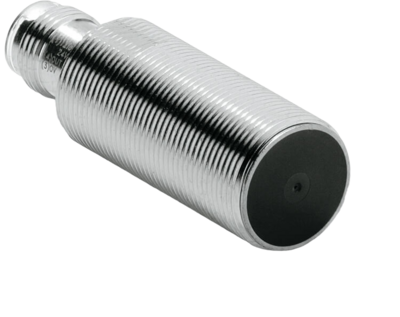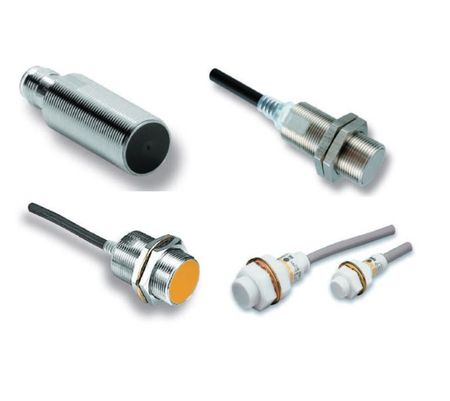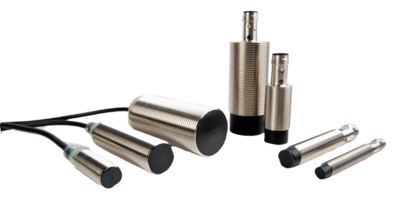Omron Inductive Sensors
omron e2a
- Response time: 0.2 ms maximum
- Release time: 0.1 ms maximum
Omron e2a m12kn08 m1 b1
e2a m12kn08 wp b1
Omron e2a m12ks04 m1 b1
Omron e2a m12ks04 m1 b2
Omron e2a m12ks04 wp b1
e2a m12ks04 wp b1 2m
Omron e2a m12ks04 wp c1
Omron e2a m12ln08 m1 b1
Omron e2a m12ls04 m1 b1
Omron e2a m12ls04 m1 b2
Omron e2a m18ks08 m1 b1
e2a m18ks08 wp b1
Distance Sensor Omron - e2a m18ks08 wp b1 2m
Omron e2a m18ln16 m1 b1
Omron e2a m18ls08 m1 b1
e2a m30kn20 m1 b1
Omron e2a m30ks15 m1 b1
Omron e2a s08kn04 m5 b1
Omron e2a s08ks02 m1 b1
Proximity sensor
- Type of sensor: Induction
- Body shape: Cylindrical
- Housing diameter: 8 mm
Omron e2a s08ls02 m5 b1
omron e2b
- Humidity: 35% to 95% RH (non-condensing)
- Vibration: 10 G at 200 Hz (maximum)
- Impact: 50 G (maximum)
- Certification: ATEX, IECEx (for potentially explosive areas)
e2b m12kn05 wp b1
Omron e2b m12ks04 m1 b1
Omron e2b m12ks04 m1 b2
e2b m12ln08 m1 b1
- Sensing Distance: 8mm
- Output type: PNP PNP
- Operating mode: NO
e2b m12ln08 wp b1
Omron e2b m12ls04 m1 b1
e2b m12ls04 wp b1 2m
Omron inductive sensors are a type of proximity sensor designed and manufactured by Omron, a global leader in automation technology and industrial solutions. These sensors use the electromagnetic induction principle to detect the presence or absence of metallic items without coming into direct touch with them. Because of their dependability and endurance, they are widely employed in many industrial applications, such as robotics, automotive systems, and factory automation.
How Do Omron Inductive Sensors Work?
Omron inductive sensors generate an electromagnetic field by use of an oscillator and an internal coil. The electromagnetic field is disturbed by the proximity of a metallic object to the sensor. The internal circuitry of the sensor detects this interruption as a shift in the oscillation pattern. Consequently, the sensor signals the existence of a metallic object.
The key components that enable this operation are
- Oscillator: This generates the electromagnetic field around the sensor.
- Coil: It creates the inductive field, which is used to detect changes caused by nearby metallic objects.
- Trigger Circuit: This circuit detects disruptions in the electromagnetic field and converts them into a digital or analog signal.
- Output Device: The signal from the trigger circuit is relayed to an output device, typically used to control other systems or alert operators.
Applications of Omron Inductive Sensors
Inductive sensors made by Omron are widely utilized in environments where non-contact detection is crucial. Their robustness and reliability make them ideal for challenging conditions such as:
- Industrial Automation: Utilized are inductive sensors to detect the position and movement of machinery parts, ensuring accurate operations on assembly lines.
- Robotics: They help guide robotic arms and ensure precision in automated tasks.
- Automotive Systems: Omron inductive sensors are used in various automotive applications, such as monitoring engine speed and position.
What are the Benefits of Using Omron Inductive Sensors?
Omron inductive sensors are highly valued in industrial automation and robotics for their reliable performance, durability, and versatility. Here are some of the key benefits of using Omron inductive sensors in your applications:
1. High Reliability
Omron inductive sensors are made to function exceptionally well, consistently detecting metallic objects without the need for direct physical touch. Because to its non-contact operation, there is less wear and tear, which extends lifespan and lowers maintenance expenses.
2. Robustness in Harsh Environments
Omron inductive sensors are designed to survive harsh environments, such as chemical exposure, dust, vibrations, and extremely high or low temperatures.
3. Versatile Applications
Omron provides a wide selection of inductive sensors for use in robotics, automotive systems, and factory automation, among other applications. Whether you need a proximity sensor to detect the presence of a metal object or a speed sensor for rotational movement, Omron has a solution tailored to your needs.
4. Precise and Accurate
Omron inductive sensors are engineered to deliver precise and accurate measurements, ensuring that your automated processes operate smoothly. This level of accuracy is crucial in applications like robotics, where even small deviations can affect overall performance.
5. Easy Integration and Compatibility
Omron inductive sensors are designed to integrate seamlessly with other automation systems, allowing for flexible installation and easy compatibility with existing equipment. This quality makes them a fantastic option for upgrading or expanding current setups without extensive reconfiguration.
6. Low Maintenance Requirements
Due to their non-contact design and robust construction, Omron inductive sensors require minimal maintenance.
7. Wide Range of Options
Omron provides a wide choice of inductive sensors, so you may select the ideal sensor depending on environmental appropriateness, accuracy, and sensing range.
Types of inductive sensors
There are several types of inductive sensors, each of which has its own characteristics and is used for different purposes.
1. Cylindrical sensors
- omron e2a: This type of sensor has a cylindrical shape and is used to detect cylindrical metal objects. It has a small diameter and can be used in limited space.
- omron e2b: This sensor type is also cylindrical in shape but has a larger diameter than E2A. It can detect objects at a greater distance.
- omron e2cy: This type of sensor is similar to E2B, but has a threaded mount, making it more resistant to vibration.
- omron e2ef: These stainless steel cylindrical inductive sensors are highly resistant to shock, vibration, and chemicals, making them ideal for use in harsh environments.
- omron e2f: Cylindrical sensors with an epoxy resin housing have a high IP68 rating, making them resistant to dust and water.
- omron e2fm: They are highly resistant to shock, vibration, chemicals, and electromagnetic interference, making them ideal for use in the harshest environments.
2. Rectangular sensors
- omron e2e: This type of sensor has a rectangular shape and is used to detect metal plates and other rectangular objects. It can detect objects in a larger area than cylindrical sensors.
- omron e2ec: This type of sensor is similar to E2E, but has a higher degree of IP protection, which makes it more resistant to dust and water.
- omron e2eh: Sensors have a compact size and affordable price, making them ideal for general applications.
3. Gap sensors
- omron e2ps: Compact size and affordable price make them ideal for general use.
- omron e2eh-s: High IP67 rating, making them resistant to dust and water.
- omron ze: High accuracy and fast response time, making them ideal for dynamic applications.
- omron zx: Wide detection range and resistant to the environment, making them ideal for use in harsh environments.
4. Vibration sensors
omron d7s-b: A compact 3-axis vibration sensor designed for earthquake and other secondary natural disaster detection.
- omron d2f-mv: This sensor is designed to detect vibration in machinery and equipment.
- omron e2pv-a: Designed to detect vibration in conveyors and other industrial equipment.
These are only a handful of the inductive sensor types that are most widely used. Numerous additional kinds of sensors exist as well, each tailored to a distinct set of uses.
Factors Should Be Considered When Choosing an Inductive Sensor
In order to guarantee maximum performance and dependability, it is essential to choose the appropriate inductive sensor for your application. Inductive sensors are versatile, but certain factors can significantly impact their functionality and effectiveness.
1. Sensing Distance
The sensing distance, also known as the detection range, is a critical factor in selecting an inductive sensor. Consider your application's requirements—whether it's short-range detection in tight spaces or longer-range detection for larger machines.
2. Size and Form Factor
Inductive sensors are available in a range of sizes and shapes, including rectangular and cylindrical. The form factor you choose should fit comfortably within the available space in your application.
3. Environmental Conditions
Although inductive sensors are made to work in challenging conditions, it's still vital to make sure they can withstand changes in humidity, temperature, dust, and chemical exposure.
4. Material Compatibility
Consider the type of metal your sensor will interact with and choose a sensor that matches your application's material compatibility needs.
5. Output Type
Digital outputs are commonly used for simple on/off detection, while analog outputs are useful for applications requiring proportional measurements or feedback. Consider what kind of output is needed for your application and whether it should be normally open or normally closed.
6. Installation Requirements
Consider factors like mounting style (flush or non-flush), cable connections, and the need for additional hardware.
7. Accuracy and Repeatability
Consider the accuracy specifications of the sensor and ensure it meets your requirements. High repeatability ensures that the sensor consistently delivers the same results over time, providing reliability in automated processes.
8. Response Time
Faster response times are crucial in high-speed applications, such as conveyor systems or robotics. Ensure the response time of the sensor matches your application's speed requirements.
For your automation and robotics systems to operate effectively and dependably, you must choose the right inductive sensor. The sensor you select will impact detection accuracy, system integration, and overall equipment performance. A poorly chosen sensor can lead to errors, downtime, and increased maintenance costs.
If you're unsure about which sensor suits your needs, our Eltra Trade managers are here to help. They can guide you through the selection process and suggest the best option for your specific application.


